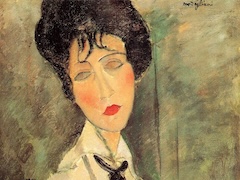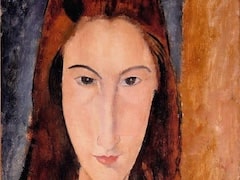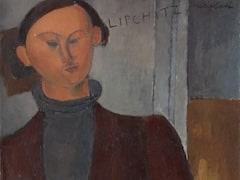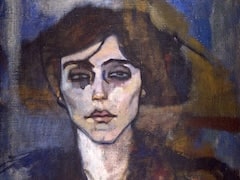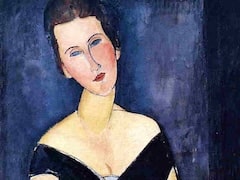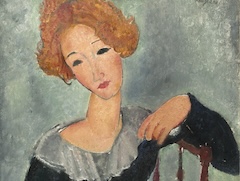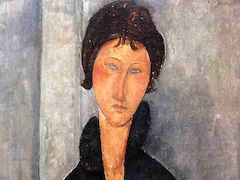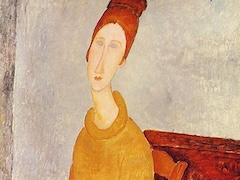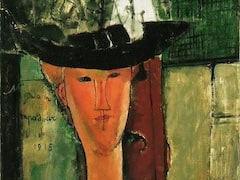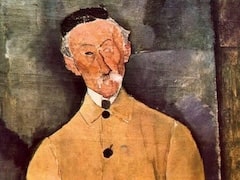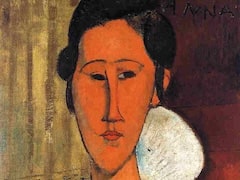Amedeo Modigliani and his paintings
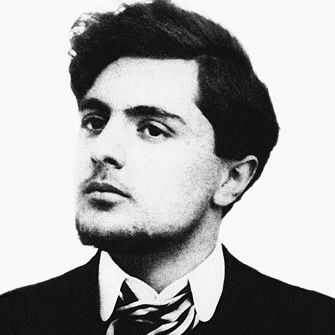
Amedeo Modigliani was born in Tuscany, and he had a strong Jewish heritage as influenced by his family. He was raised in Livorno, a small yet thriving city in Italy. During his childhood years, Modigliani lived in the city of Livorno that was known to be the centre of commerce famous for shipwrighting and seafaring. However, the city had a longer history of being a place of refuge for people that were harshly persecuted for practicing their religion. In fact, Solomon Garsin, Modigliani's great-great-grandfather was a Jewish refugee who transferred to Livorno during the 18th century.
Modigliani's parents were Flaminio and Eugenia Garsin. Earlier during his life, his family had a comfortable life because of a successful money-changing business. However, the Modiglianis suffered from a tough financial status due to a bankruptcy. Because of this unfortunate situation, the family lived in poverty.
The young boy was much closer to his mother. In fact, she educated Modigliani until he reached 10 years of age. When he was 11, he suffered from pleurisy, which eventually progressed to typhoid fever. About 5 years later, he became ill once again with pleurisy and tuberculosis that nearly ended his life. With his mother's great love and care, Modigliani was able to recover completely. Upon his recovery from his diseases, he was accompanied by his mother to a fascinating tour throughout Southern Italy. Among the places they visited included Rome, Amalfi, Capri, Venice, Florence and Naples.
With his particularly close relationship with his mother, the budding artist became more inspired to pursue his love for art as a primary vocation. It is also worth noting that the artist was often found to be painting and drawing from an early age. He discovered his love and skill in art, and this all started even before he pursued formal studies.
When he was suffering from typhoid fever, he was inspired to visit Florence to view the astounding paintings in the Uffizi and the Palazzo Pitti. When he recovered from his illness, his mother took him to Florence to view these paintings. Aside from taking a tour to this city, he obtained training from Guglielmo Micheli, a painting master in the city of Livorno.
During the years 1898 to 1900, Modigliani decided to work in the Micheli's Art School. It was here where he had his formal art instruction. Moreover, the environment supported his passion for art, and he acquired great skill in the 19th century Italian art. In his early Parisian works, it was evident that his masterpieces were largely influenced by his knowledge of Renaissance art. Among a few others, his inspirations included Leonardo da Vinci, Michelangelo, Titian, and Caravaggio.
When Modigliani was still in Rome, in 1901, he was greatly inspired by the works of Domenico Morelli. The artist was noted for his masterpieces that featured scenes and images from the Bible and literature.
As a student of Micheli, the young Modigliani was learned more about various other themes included still-life, portraiture, the nude and landscape. By 1902, the artist continued his passion for life drawing and this was the reason for his decision to study at the Accademia di Belle Arti, which was situated in Florence.
In 1906, he opted to relocate to Paris, which was famous for avante-garde art. When Modigliani arrived in Paris in 1906, the first influence that he underwent was not that of Picasso, nor that of the Fauves, nor even that of Cezanne, whom he had still to discover. Meidner, who knew Modigliani in Paris at that time, records that he admired not only Gauguin but also expressive style of Van Gogh. It was arrival to Paris that enabled him to present his artistic experimentation alongside other artists including Georges Seurat, Piet Mondrian and Picasso. Eventually he developed his own unique style, which cannot be adequately categorized with those of other artists.
While in Paris, Modigliani remained in Le Bateau-Lavoir, which was famous for struggling artists who lived in the city. He rented a studio where he pursued his passion in art despite his financial struggles.
Although he lived a difficult life in the Montmartre, he strove to appear as presentable as he could be. While his wardrobe was never the sophisticated type, he still tried his best to look decent. The artist also adopted a bohemian way of life, and he had also aimed to rise back from challenging times.
When he first came to Paris, Modigliani frequently sent letters to his mother. He also maintained discipline in drinking, and he often sketched nudes during his classes at the Colarossi School. Since he was new to the city, he was rather reserved and barely socialized with a lot of people.
After he became well-adjusted in Paris, his reputation slowly changed until he became more as a rebellious artist. In fact, his studio was often in disarray, and he became both an alcoholic and a drug addict. However, it was also during this time that the artist was developing his talents slowly, as depicted in his artworks and unique way of thinking.
Soon, Modigliani began to reject his earlier works as he believed that he lacked much knowledge and skill in art during those years.
During the latter years of his life, Modigliani continued with his artworks. Unfortunately, his health was beginning to fail him due to his addictions to alcohol. By 1920, his neighbors noticed that he had barely gone out for quite a number of days. When his neighbor checked on him, Modigliani was found to be delirious in bed. He was also holding onto his partner who was then about 9 months in her pregnancy.
Although a doctor was summoned by his neighbor, not much could be done as the artist was already dying of a terrible disease called tubercular meningitis. Hence, he died from this ailment on January 24, 1920. A funeral was attended by several artists in the communities of Montparnasse and Montmartre. Amedeo Modigliani died in poverty, yet his exceptional reputation soared after his death. He became the epitome of the tragic artist, creating a posthumous legend almost as well known as that of Vincent van Gogh.
His life inspired numerous artists, and various novels, feature films and other tributes were produced in memory of this remarkable artist who contributed so much to the history of art.

